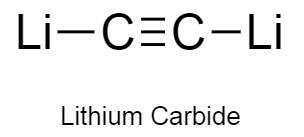
The carbide of Lithium has the formula:
A.
B.
C.
D.
Answer
480.3k+ views
Hint:The compounds that consist of carbon and less electronegative elements and that are distinguished by their chemical bonding (ionic or covalent) are known as carbides. They are generally prepared at high temperatures.
Complete step by step answer:
Carbides are compounds that consist of carbon and less electronegative elements.
Carbides are usually prepared at very high temperatures from metals and metal oxides by combining metal with carbon.
They are extremely stable and have high melting points.
Lithium carbide:
a)Lithium carbide consists of lithium atom bonding to carbon carbon triple bond.
b)The structure of lithium carbide is as follows:

a)It is also known as dilithium acetylide.
b)It was first produced by Mossan.
c)It is insoluble in organic solvents.
d)It was first produced using lithium carbonate in the reaction given below:
In this reaction when lithium carbonate reacts with carbon atoms it forms lithium carbide along with the carbon monoxide gas.
a)It is also prepared from various other reactions. The reactions are as follows:
1.When lithium hydride reacts with graphite it forms lithium carbide in the reaction given below:
2.When metallic lithium reacts with ethylene in the atmosphere it produces lithium carbide.
Uses of Lithium Carbide:
-It is used in the carbon dating procedures.
So the correct answer is option D i.e
Note:
-In lithium carbide, carbon-carbon atoms have a triple bond .
-Lithium carbide is often confused with lithium carbonate because of the similarity in their name and some of the properties. Also it has similar properties as of calcium carbide and is the only stable alkali metal that reacts with the graphite.
Complete step by step answer:
Carbides are compounds that consist of carbon and less electronegative elements.
Carbides are usually prepared at very high temperatures from metals and metal oxides by combining metal with carbon.
They are extremely stable and have high melting points.
Lithium carbide:
a)Lithium carbide consists of lithium atom bonding to carbon carbon triple bond.
b)The structure of lithium carbide is as follows:

a)It is also known as dilithium acetylide.
b)It was first produced by Mossan.
c)It is insoluble in organic solvents.
d)It was first produced using lithium carbonate in the reaction given below:
In this reaction when lithium carbonate reacts with carbon atoms it forms lithium carbide along with the carbon monoxide gas.
a)It is also prepared from various other reactions. The reactions are as follows:
1.When lithium hydride reacts with graphite it forms lithium carbide in the reaction given below:
2.When metallic lithium reacts with ethylene in the atmosphere it produces lithium carbide.
Uses of Lithium Carbide:
-It is used in the carbon dating procedures.
So the correct answer is option D i.e
Note:
-In lithium carbide, carbon-carbon atoms have a triple bond .
-Lithium carbide is often confused with lithium carbonate because of the similarity in their name and some of the properties. Also it has similar properties as of calcium carbide and is the only stable alkali metal that reacts with the graphite.
Latest Vedantu courses for you
Grade 10 | MAHARASHTRABOARD | SCHOOL | English
Vedantu 10 Maharashtra Pro Lite (2025-26)
School Full course for MAHARASHTRABOARD students
₹31,500 per year
Recently Updated Pages
Express the following as a fraction and simplify a class 7 maths CBSE

The length and width of a rectangle are in ratio of class 7 maths CBSE

The ratio of the income to the expenditure of a family class 7 maths CBSE

How do you write 025 million in scientific notatio class 7 maths CBSE

How do you convert 295 meters per second to kilometers class 7 maths CBSE

Write the following in Roman numerals 25819 class 7 maths CBSE

Trending doubts
State and prove Bernoullis theorem class 11 physics CBSE

What are Quantum numbers Explain the quantum number class 11 chemistry CBSE

Write the differences between monocot plants and dicot class 11 biology CBSE

1 ton equals to A 100 kg B 1000 kg C 10 kg D 10000 class 11 physics CBSE

State the laws of reflection of light

In northern hemisphere 21st March is called as A Vernal class 11 social science CBSE




